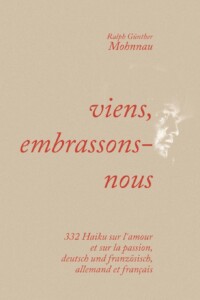Title: viens, embrassons-nous
Author: Ralph Günther Mohnnau // Translated into French from German by Patrick
Démerin
Graphisme de Wol Müller
Publisher: Trafford
ISBN: 978-1-6987-1589-6
Genre: Poetry / International (French / German)
Reviewer: Margie Przybylski
Pacific Book Review
 Viens, embrassons-nous (Come, Let’s Kiss Each Other) is a captivating collection of
Viens, embrassons-nous (Come, Let’s Kiss Each Other) is a captivating collection of
haiku originally written in German by Ralph Günther Mohnnau and translated into
French by Patrick Démerin, with graphic design by Wol Müller. This trilingual work
elegantly intertwines German precision with the romantic undertones of French, all
within the compact and evocative structure of the haiku, a poetic form originating from
Japan.
Démerin begins the book with an insightful introduction to haiku, offering readers a brief
yet informative exploration of this ancient form of poetry. Although most poetry
enthusiasts are familiar with haiku’s 5-7-5 syllable structure and its Japanese origins,
Démerin’s introduction adds depth by explaining how the minimalist nature of haiku
aligns with expressions of love, making it particularly suited to intimate, romantic
themes. This context sets the stage for what is to come – a series of short, poignant
reflections on love and life, rendered in both German and French.
One of the most delightful aspects of viens, embrassons-nous is the visual impact of
seeing the poems presented side-by-side in two languages. The haikus appear to “kiss”
each other on the page, an idea that gave me goosebumps and evoked a smile. This
duality mirrors the interplay between two lovers or two cultures, beautifully exemplified
in one haiku: “Rolling pebbles on the beach – white pebble you, brown pebble me.”
This delicate image encapsulates the essence of intimacy while celebrating the blending
of different worlds. Each haiku manages to convey a profound sense of closeness and
affection, whether in moments of playful innocence or more passionate encounters.
The author’s decision to translate German haikus into French is not only linguistically
fascinating but also culturally enriching. French, often associated with love and
romance, provides the perfect canvas for these delicate, emotional pieces. In one haiku,
the sensuality is palpable:”She sleeps, her shirt undone – where silk was, now there is
silken skin.”
Müller’s ability to maintain the haiku’s concise beauty while conveying the same
emotional weight in both languages is impressive. The translation process must have
been a challenge, but the result is a seamless interplay between the two languages,
each haiku retaining its original charm while gaining new life in translation.
Viens, embrassons-nous is not just a collection of haikus – it is an artistic experience
that crosses linguistic and cultural boundaries. The inclusion of the original German text
allows bilingual readers to appreciate the nuances of each language, and for those
unfamiliar with German or French, an online translator or a multilingual friend will help
convey the beauty of these poems.
This collection is a delightful read for leisure, but it also serves as a valuable resource in
academic settings for students of language, literature, and translation. It exemplifies the
universal nature of love, proving that regardless of language or culture, emotions can be
expressed with clarity and elegance. I highly recommend this book to anyone who
enjoys poetry, multilingual works, or simply wishes to indulge in the beauty of love,
expressed in a simple form – haiku.


